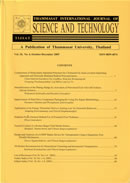ThaiScience
ThaiScience
THAMMASAT INTERNATIONAL JOURNAL OF SCIENCE & TECHNOLOGY
Volume 24, No. 02, Month APRIL, Year 2019, Pages 6 - 14
Effect of ammonium sulfate on the porous creating of regenerated cellulose hydrogel from palm oil trunk
Nantharat Phruksaphithak, Anuwat Sukthong, Warintorn Muanpannarai, Atima Theptong
Abstract Download PDF
Oil palm is an oil plant which is of great importance for both the Thai and the world economies. Oil palm trees have a life span of approximately 20-25 years before a gradual erosion of yield sets in. Oil palm trunk (OPT) is an agricultural residue waste from oil palm re-plantation which is rich in cellulose but utilized ineffectively. One way for OPT utilization is cellulose hydrogel production. In this study, cellulose hydrogel was prepared by dissolving cellulose from OPT with 7% (w/v) of lithium chloride in dimethylacetamide (LiCl/DMAc) to create a porous hydrogel by 1, 3, 5, 8 and 10% (w/v) of (NH4)2SO4 for 3, 5 and 10 minutes. After that, it was found that soaking cellulose hydrogel in 8% (w/v) of (NH4)2SO4 solution for 5 minutes created light-browed cellulose hydrogel with an average Shore A hardness of 41 ± 1.13 and a maximum swelling equal to 90%. The chemical functional group and cross-section morphology of cellulose hydrogel were determined using Attenuated total reflectance - Fourier transform infrared spectroscopy (ATR-FTIR) and Scanning electron microscopy (SEM), respectively.
Keywords
Oil palm, Cellulose hydrogel, Ammonium SulfateTHAMMASAT INTERNATIONAL JOURNAL OF SCIENCE & TECHNOLOGY
Published by : Thammasat University
Contributions welcome at : http://www.tijsat.tu.ac.th
